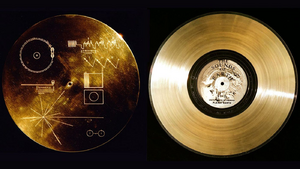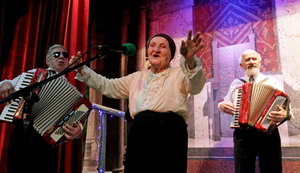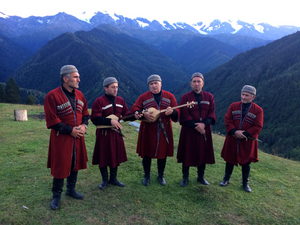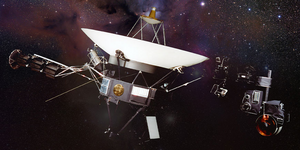Chakrulo: Polyphony Among the Stars
| Title | Chakrulo: Polyphony Among the Stars |
|---|---|
| Author | Anna Lia Olivo |
| Date | 2025-03-11 |
Imagine a message in a bottle cast into the infinite expanse of the cosmos. It crosses the darkness of space and time, carrying with it a mark of our existence.
In 1977, humanity made an extraordinary gesture: sending a sound signal into the future, a cultural and symbolic testament of our planet. This “time capsule” is called Golden Record, a copper disk plated in gold that was sent aboard NASA's Voyager 1 and Voyager 2 spacecraft. The Golden Record contains images, sounds, and music meant to tell the story of Earth to any potential extraterrestrial civilizations, a message of hope and knowledge.
Among the selected musical tracks for this interstellar journey, one of the most captivating comes from Georgia. Chakrulo is not simply a melody; it is an expression of cultural resilience. Originating from the Georgian region of Kakheti, the piece embodies the traditional polyphony of this area, a type of singing in which multiple voices intertwine, creating a complex and engaging sonic tapestry. Georgian polyphony, recognized by UNESCO as an Intangible Cultural Heritage of Humanity, is an extraordinary example of how music can be both an art form and a historical testament.

Georgian Polyphony
Georgian polyphonic singing is a musical tradition rich in history, closely tied to the culture and everyday life of the country. Its beauty, distant from Western harmonies, challenges the ear with modulations and sudden shifts, creating a complex and captivating melody. Sacred polyphony, sweet and meditative, has accompanied religious celebrations for over fifteen hundred years, blending with Christianity as well as with pagan and Byzantine traditions. Despite its strong religious component, polyphonic songs also address themes related to daily life, nature, love, popular traditions, and the struggle for freedom.
Thanks to their geographical isolation, due to the mountains that surround them, the Georgian regions have developed their own unique style of singing, which they defend with passion and pride. From the monophonic songs of the eastern valleys to the lively melodies of Guria on the Black Sea coast, the intricate vocal harmonies, involving three or more voices, envelop the listener in a musical embrace that blends the sacred and the secular, the past and the present.

Ancient instruments such as the salamuri (a whistle flute), the panduri (lute), and the choghur (plucked string instrument) accompany the voices, creating a symphony that transcends time and space. Each note tells a story, a deep connection to the land, the mountains, the rivers, and the sky of Georgia.
The Golden Record: A Cultural Choice
The selection of tracks for the Golden Record was entrusted to a committee of international experts, including the astronomer Carl Sagan. The goal was not only to represent the music of the great Western classical traditions but also to celebrate the variety and depth of world cultures. Among the chosen tracks were works by Beethoven, Bach, and Mozart, but also folk music from various parts of the world. The decision to include Chakrulo among these compositions is particularly significant: it not only represents a refined and unique musical form but also carries the message of a culture that has managed to defend itself against forces attempting to erase it.
At the time, Georgia was part of the Soviet Union, living under a regime that tried to standardize its cultural traditions to a Soviet model. In this context, Chakrulo was not only a musical piece, but an act of resistance against the imposition of a foreign culture. While the Russian proposal for the Golden Record included Moscow Nights, a song that glorified life under the regime, Chakrulo carried a completely different vision. It did not celebrate unity forced by Soviet power, but told the story of a people determined to fight to preserve their identity. Music thus became a battlefield, a means through which the Georgian people asserted their existence.

The Message of Chakrulo Today
In 2017, Georgia celebrated the 40th anniversary of the launch of the Voyager probes and the selection of Chakrulo for the Golden Record. This anniversary provided an opportunity to reflect on the meaning of this song as a symbol of resistance. Across Georgia, events, concerts, and conferences were organized to commemorate this anniversary, emphasizing the importance of this emblematic gesture.
The celebrations kicked off with the arrival of Rob Manning, the legendary Chief Engineer of NASA's Mars Program, and John Casani, the former Project Manager of the Voyager mission, who came to Tbilisi from September 25 to 28. These prominent figures participated in a series of lectures and roundtable discussions about space exploration, including a special interactive lecture for children at the Opera House. The highlight of the celebrations was concert by the Georgian State Singing and Dancing Ensemble, Erisioni, on September 28. The same ensemble that recorded Chakrulo for the Golden Record performed the song for an eager audience. The performance held even greater significance as Rostom Saginashvili, one of the original singers of Chakrulo, shared the stage with John Casani, symbolizing a reunion between the voices of the past and the pioneers of space exploration.

Additionally, filmmaker Ramaz Bluashvili, whose father was part of the ensemble that recorded Chakrulo, used the anniversary as the perfect occasion to debut his documentary chronicling the song’s journey into space. Having spent years researching the story, Bluashvili met with key members of the Voyager team, helping to shine a spotlight on the song’s global importance as a piece of human heritage.
This series of events not only celebrated Georgia's contribution to space exploration but also emphasized the lasting power of Chakrulo as a symbol of national identity and resilience on the world stage. Its inclusion on the Golden Record serves as a testament to the enduring nature of the traditions and stories of small, often overlooked peoples, proving that they can transcend the barriers of time and space.
A Song Among the Stars
As the Voyager 1 and 2 probes continue to travel through infinity, Chakrulo resonates in the vastness of space, merging with the cosmic silence as an eternal song of resistance and survival. Imagining a distant civilization listening to this melody gives us hope for the future and reminds us that, even in the darkest moments, culture, freedom, and identity can thrive, fueling the strength of those who fight for a brighter future.
Bibliography
- NASA, "Voyager Captures Sounds of Interstellar Space", September 2013, https://www.jpl.nasa.gov/images/pia17045-voyager-captures-sounds-of-interstellar-space/.
Georgian Journal, "The Untold Story of How "Chakrulo" Ended Up in Space", September 2014, https://georgianjournal.ge/discover-georgia/28321-the-untold-story-of-how-chakrulo-ended-up-in-space.html.
- S. Iacobellis, "Quando la Musica in Georgia era oppressa dall'Unione Sovietica", in InsideOver, June 2022, https://it.insideover.com/storia/musica-georgia-oppressa-russia.html.
- G. Grossi, "La polifonia della Georgia", in Osservatorio Balcani e Caucaso Transeuropa, June 2016, https://www.balcanicaucaso.org/aree/Georgia/La-polifonia-della-Georgia-170980.
- D. Amenta, "Ciao extraterrestri, qui Pianeta Terra. Volete ascoltare con noi Bach o Chuck Berry?", in Tiscali Cultura, June 2021, https://cultura.tiscali.it/storie/articoli/Voyager-Golden-Record-Nasa-Disco-extraterrestri-alieni-spazio-cosmo/.
- G. Lomsadze, "Georgia Celebrates Sending a Song Into Space", in Eurasianet, September 2017, https://eurasianet.org/georgia-celebrates-sending-a-song-into-space-0.